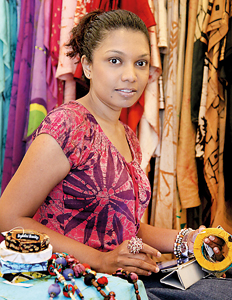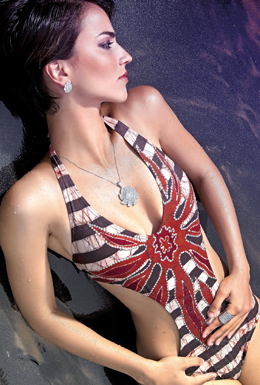Batik with a touch of oomph!
View(s):Modernising a traditional art form by designing clothes she would like to wear is what Darshi, of Buddhi Batiks fame, does best. Here she speaks to Smriti Daniel
Darshi Keerthisena is that rare hybrid – an astute businesswoman and the head of her own company on one hand and on the other a master designer with an enviable body of work to her credit. Where you might see an item of clothing, Darshi sees a canvas and way to reinvent an old and beloved art form. Nobody does batik quite like her.

Darshi: Creating a fusion of the best of the West and East. Pic by M.A. Pushpa Kumara
Darshi wears a batik t-shirt paired with a denim skirt to her interview with the Sunday Times.
That she would happily wear most of what you’d find on Buddhi Batik’s shelves provides critical insight into Darshi’s design philosophy.
The company her father founded has been bigger than it is now – in the ’80s they had 350 people on their staff, now they only have 60 – but the company suffered when tourism died off as the civil war heated up.
When she returned to designing with batik Darshi knew she would be swimming against the tide. “It was considered very old fashioned and younger people didn’t really like batik at all,” she says. “It hadn’t been updated design-wise.” While it’s hard to change the essential appearance of batik, what Darshi could change were the cuts, the colours and the textiles.
“Batik is such a great medium because you can do pretty much anything.” For her it was about pairing a Sri Lankan art form with what was hot on the international runways – her clothes would take on the vibrancy and intricacy of batik but the form and shape of western clothing. “I decided to do something about it and make something I would like to wear myself.” So it wasn’t just sarees Darshi had her eye on, but swimwear, t-shirts, evening gowns and even bags – anything really that could be made with batik.
It wasn’t a revolutionary move – Darshi says her father was among the first to design batik swimwear. Growing up, Darshi knew her parents were totally invested in Buddhi Batiks, the company Buddhi and Ranasiri Keerthisena had founded in 1970. “I had so much inspiration from my parents. When I look at some of their catalogues and some of the things they had done…they set the standard I had to start from.” Her family made the village of Koswadiya both their home and workshop. “My backyard was our workshop and I pretty much grew up with it,” says Darshi, explaining that they only moved to Colombo when she became a teenager.

Beauty queen and Bollywood star Jacqueline Fernandez Shows off a Darshi creation
One of her first attempts at design was a shirt she made for her elder brother’s birthday – he wore it till it was completely faded. “I remember I wanted to do something pretty funky,” Darshi says with a laugh.
As a designer now, Darshi’s great passion is sarees and left to herself, she more often than not picks a floral theme, with a focus on orchids.
To judge a design properly, you would have to wear it. Darshi tries on most every piece that comes in from her workshop to see how the design drapes on the human form. She sees such “surface design” as her strength and her passion, something that prompted her to leave a job at Brandix where she designed for the Marks and Spencer account among others.
Darshi had found her way there after a stint in Singapore where she earned a diploma in fashion design followed by a full blown B. A. Hons in Fashion and Textile Design from the Birmingham City University in the UK. She would be at Brandix for five years, but says she felt the need to really challenge herself and give the designer inside full rein. So she returned to the family fold in 2005.
Today, she heads a team of three in-house designers and says she establishes the parameters of their design concept for the year and chooses the themes (a few weeks ago, the theme was was Marrakesh and Morocco) aside from working on individual designs. A great deal of research and thought goes into each new line. Though it seems essential to her now, Darshi says that this kind of considered approach is something she learnt during her Bachelor’s and that it didn’t come naturally. “I found that part very hard, “ she says, adding “we now invest a lot of time and effort on developing a product.”
Increasingly, Darshi has begun looking outside the studio for new talent. When she finds a new batik artist or one approaches her she will often do a free design for them – if the work meets her standards she invites the artist to put it on sale in her shop, if not, he or she can sell the work on their own. Darshi is also keen on expanding her range of handicraft products by local artisans – she’d like to have more on display and sees it as essential to sustaining these threatened but unique art forms.

Despite the time spent on running the business, Darshi still sees herself as an artist first.
“I want to spend more time designing but I have to manage the business as well,” she says. “I’m forced into it. When you’re trying to be an entrepreneur you have to be a little bit of an all-rounder.” Luckily, along with her love of batik, she’s inherited a solid work ethic from her parents.
She tells a story of how her father has always expected success to go hand in hand with hard work – that’s simply how things are.
When Darshi became the mother of Arya, 2 ˝ years ago, she found that she had to reinvent herself again.
She loves being a mum and is constantly trying to figure out ways she can spend more time with her little girl.
It’s meant working more from home but Darshi isn’t compromising on her dreams.
She’d like to see Buddhi Batiks continue to produce new and exciting garments and become a bigger presence in the international market.
She knows they have a good formula in place, and that in producing a batik garment she’s creating a hybrid like herself – a fusion of the best of the West and the East.
Follow @timesonlinelk
comments powered by Disqus





















